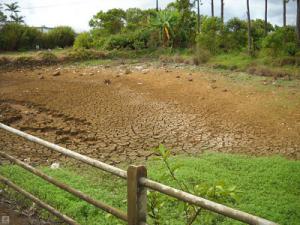DroughtsPast strategies for managing droughts are obsolete in a hotter, more densely populated world
California’s current extreme drought must be a lesson for managing water in a warmer, more densely populated world, experts say. The Golden State has a long history of successfully managing droughts, but strategies from the past century are now obsolete, they assert. The current drought, which began in 2012, is a harbinger of what is to come. Engineering our way around periodic water shortages will no longer work in a hotter, drier world with ceaseless human demands on water supplies. Our ever-increasing thirst for water coupled with poor management, aging infrastructure and worsening climate change is a recipe not just for wells run dry, but for ravaged forests, extinct wildlife, and more droughts. Targeted research and public policies that move beyond a crisis response mentality are critically needed, the experts conclude.

Parched land in drought-stricken land // Source: commons.wikimedia.com
In drought-stricken California, lots of families have dinnertime discussions about water, but rarely do they have the same depth and insight as those happening in the AghaKouchak household. Amir AghaKouchak, assistant professor of civil & environmental engineering at the University of California, Irvine, is an expert on drought and water issues; and his wife, Nasrin Nasrollahi, is an engineer at the Orange County Sanitation District who works on treating recycled water and replenishing groundwater supplies.
“We have drought-related discussions all the time,” says AghaKouchak. “We talk about drought and its effect on the water quality and inflow into sanitation system facilities. Because of drought, we have less stream flow and runoff. It means the levels of turbidity go up and down, depending on the location.”
UCI notes that in the last two weeks of August, his work has appeared in three of the world’s leading scientific journals: Nature, Proceedings of the National Academy of Sciences, andScience.
“I am proud to join colleagues in these publications,” he says. “The impacts of drought and climate change are of such importance to Californians and people around the world. I hope these writings will encourage the scientific community and the broader public to take these issues seriously.”
Born and raised in Iran, AghaKouchak attended K. N. Toosi University of Technology in Tehran. “When I first started, I was interested in structural engineering and construction management. I didn’t know anything about water or climate at the time,” he says. “But slowly, over time, I got more and more interested in water management issues. Before I knew it, I’d earned a master’s and a Ph.D. in this area.”
AghaKouchak and Nasrollahi met as university students in Tehran, and together they pursued advanced degrees and research at the University of Stuttgart in Germany, and the University of Louisiana. When she applied for Ph.D. candidacy at UCI, Nasrollahi brought her husband along on a visit to the office of her prospective adviser, Soroosh Sorooshian, UCI Distinguished Professor of civil & environmental engineering and Earth system science. It was a productive meeting: Sorooshian went on to recruit Nasrollahi for his department’s doctoral program and to hire AghaKouchak as a postdoctoral scholar.
